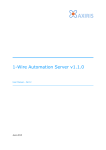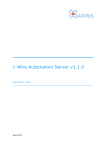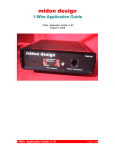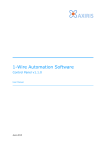Download 1-Wire Automation Server Logger User Manual
Transcript
1-Wire Automation Server Logger
v1.1.0
User Manual
June 2015
1-Wire Automation Server Logger v1.1.0
Table of Contents
1
Overview
5
2
Third-party Resources
MySQL
PostgreSQL
6
6
6
3
Command Line
7
4
Running the Logger
Current Directory
Windows
Control Panel
Command Line
Stopping the Logger
Linux
Required Privileges
Starting the Logger
Stopping the Logger
8
8
8
8
8
9
9
9
9
10
5
Configuration File
Overview
Path
Contents
Logging Destination
11
11
11
11
12
6
Text Composition
Overview
Textual Element: Constant String
Textual Element: Character Code
Textual Element: Variable
Temperature Variables
PIO State Variables
Register Variables
ROM Code Variable
Variable: Current Date and Time
Variable: Sense Date and Time
Variable: Sensor Identifier
Variable: ROM Code
Variable: Temperature
Variable: Temperature Register
Variable: Voltage VAD Pin
Variable: Voltage Register VAD Pin
13
13
14
14
14
15
15
15
15
16
16
16
17
17
17
17
17
2
User Manual
1-Wire Automation Server Logger v1.1.0
Variable:
Variable:
Variable:
Variable:
Variable:
Variable:
Variable:
Variable:
Variable:
Variable:
Variable:
Variable:
Variable:
Variable:
Variable:
Variable:
Variable:
Variable:
Variable:
Variable:
Variable:
Variable:
Variable:
Variable:
Variable:
Variable:
Variable:
Voltage VDD Pin
Voltage Register VDD Pin
Voltage VIN Pin
Voltage Register VIN Pin
Current
Current Register
Current Accumulator
Current Accumulator Register
ADC Inputs
ADC Input Registers
PIO Sensed
PIO Output
PIO Activity
PIO Count
RSTZ Configuration
Counter
Power Mode
Thermocouple Hot Temperature
Thermocouple Hot Temperature Register
Thermocouple Cold Temperature
Thermocouple Cold Temperature Register
Thermocouple Fault
Thermocouple Unconnected
Thermocouple Open Circuit
Thermocouple Short to GND
Thermocouple Short to VCC
Address Pins
18
18
18
18
18
19
19
19
19
19
20
20
20
20
20
21
21
21
21
21
22
22
22
22
22
23
23
7
Trigger
Overview
Matching Criterion
Logging Action
Processing Sensor Data
24
24
24
24
25
8
Connection with 1-Wire Automation Server
26
9
Connection with MySQL Database
28
10 Connection with PostgreSQL Database
30
11 Text File
32
12 Software Revision History
34
13 Legal Information
35
User Manual
3
1-Wire Automation Server Logger v1.1.0
Disclaimer
Trademarks
35
35
14 Contact Information
35
Revision History
Date
Authors
Description
2015-03-06 Peter S'heeren
Initial release.
2015-06-16 Peter S'heeren
Added section ROM Code Variable.
Second release.
4
User Manual
1-Wire Automation Server Logger v1.1.0
1 Overview
The 1-Wire Automation Server Logger, called the logger throughout this document, is a
powerful software tool for automating data acquisition and data logging in 1-Wire-based
projects.
The logger is a client of the 1-Wire Automation Server, called the 1-Wire server
throughout this document.
The logger can connect with multiple 1-Wire servers and multiple databases at once, and
generate multiple text files at the same time, offering great flexibility in your logging
strategy.
When a database server is temporarily unreachable, the logger buffers all sensor data in
memory. Once the database is up and running again, the buffered data is committed. As
a result no data is lost during periods a database is offline.
User Manual
5
1-Wire Automation Server Logger v1.1.0
2 Third-party Resources
MySQL
If you want to log to a MySQL database, the logger must load the MySQL library. You can
download the software from the MySQL website.
MySQL home page: http://www.mysql.com/
If you're running Linux, the package manager that comes with your Linux distribution
usually includes the latest version of the MySQL library.
PostgreSQL
In order to log data to a PostgreSQL database, the logger must load the PostgreSQL
library. The library can be downloaded from the PostgreSQL website.
PostgreSQL home page: http://www.postgresql.org/
If you're running Linux, the package manager that's part comes with your Linux
distribution usually includes the latest version of the PostgreSQL library.
6
User Manual
1-Wire Automation Server Logger v1.1.0
3 Command Line
Parameter
Description
-service
Run the program as a service. For this to work, the program must be
installed as a Windows service.
-console
Open a console. This parameter as no effect when the program is run as
a service.
-v
Enable verbose output.
-h
Display help and exit.
-cfg FILE
Specify configuration file.
Parameters -service and -console are specific to the Windows version of the logger.
The -cfg parameter overrules the default configuration file. The given filename may
include an absolute or relative path.
User Manual
7
1-Wire Automation Server Logger v1.1.0
4 Running the Logger
Current Directory
When the logger starts up, it changes its current directory to the location where the
logger's executable file resides. This is also the directory where the 1-Wire Automation
Software installer puts the program files, unless of course you've moved the files to
another directory.
The current directory acts as the base directory for filenames that are specified with a
relative path. This is true in the following places:
▪
Command line parameter -cfg.
▪
Configuration file keyword textfile.
▪
Configuration file keyword library in mysql block.
▪
Configuration file keyword library in pgsql block.
▪
Configuration file keyword filename in textfile block.
Windows
Control Panel
The control panel application
offers a convenient way of
configuring and running the
logger (and server). The 1Wire Automation Software
installer creates a shortcut
on your desktop. When the
control panel is running, it
shows an icon in the
desktop's tray for quick
access.
The graphical interface enables you to run the logger as an application or a Windows
service. You can configure command line parameters, start and stop the logger as
application or Windows service, install the logger as a Windows service, etc. Please read
the 1-Wire Automation Software Control Panel user manual for more information.
Command Line
You can run the logger from the command line. In this environment, you run the logger
as an application.
You can't run the logger as a service from the command line; specifying parameter
-service won't work. Use the control panel application or the Windows Service Control
Manager to start and stop services.
The following examples assume the current directory in the command line interpreter is
changed to the location of the logger executable file.
8
User Manual
1-Wire Automation Server Logger v1.1.0
> owsaslogger.exe
This command runs the logger in the background, thus as an invisible program. The
logger loads the default configuration file.
> owsaslogger.exe -console -v -cfg d:\myowsaslogger.cfg
This command runs the logger with a console and verbose output enabled. The specified
configuration file is loaded.
> owsaslogger.exe -v > owsas.log
The logger is run in the background. The logger loads the default configuration file.
Verbose output is written to the specified file.
> owsaslogger.exe -h
The logger displays the help screen and exits.
Stopping the Logger
In Windows, the logger can be stopped gracefully using the following methods:
▪
Stop the logger in the control panel application.
▪
If the logger has a console, press CTRL+C, press CTRL+BREAK, or click the console
window's close button.
Linux
Required Privileges
The logger can be run with or without root privileges.
The 1-Wire Automation Software is installed as root user, hence all installed files are
owned by the root user, including the provided configuration files. Most users want to use
these configuration files, possibly modified, so the logger must have root privileges in
order to be able to access these files.
As a rule of thumb, run the logger with root privileges.
Starting the Logger
The following examples assume the current directory in the shell is changed to the
location of the logger executable file.
# owsaslogger -v -cfg /home/peter/myowsaslogger.cfg
Verbose output is enabled. The specified configuration file is loaded.
# owsaslogger -v > owsaslogger.log &
This command runs the logger in the background, detached from the console. The logger
loads the default configuration file. Verbose output is written to the specified file.
# owsas -h
The logger displays the help screen and exits.
User Manual
9
1-Wire Automation Server Logger v1.1.0
If you want to run the logger when Linux starts up, relying on cron is a good choice. You
can edit the cron table as follows:
# crontab -e
Stopping the Logger
In Linux, the logger can be stopped gracefully using the following methods:
▪
Send signal SIGTERM to the logger.
▪
If the logger is attached to a console, press CTRL+C.
Use the kill program to send the SIGTERM signal. For example, if the process identifier of
the logger is 18108, send SIGTERM from the shell:
# kill 18108
Use killall if you want to specify the program name rather than the process identifier:
# killall owsaslogger
Note that killall sends the SIGTERM signal to all processes with the specified name. If
you're running multiple instances of owsaslogger, the killall command will terminate all
of them.
10
User Manual
1-Wire Automation Server Logger v1.1.0
5 Configuration File
Overview
When the logger starts up, it processes a configuration file. This file contains essential
information for setting up the logging operation.
The logger treats the configuration file as read-only. The logger will never write a
configuration file to disk.
The configuration file must use one of these character encoding schemes: UTF-8, UTF-16
Little Endian, or UTF-16 Big Endian. The logger recognizes the character encoding by
means of the byte order mark (BOM) at the beginning of the file. If no byte order mark is
present, the logger assumes the file is encoded as UTF-8.
Note that UTF-8 encoding is a super set of ASCII characters 0..127. This means you can
create a configuration file with a simple ASCII editor.
Path
If command line parameter -cfg is specified, the given filename overrules the default
configuration file. The filename may include an absolute or relative path. If the path is
relative, the location of the logger's executable file acts as the base directory. The given
filename must exist, else the logger stops with an error.
If command line parameter -cfg isn't specified, the logger assumes a default
configuration file is located in the program directory. The default configuration file is
called owsaslogger.cfg.
Contents
The configuration file is made up of statements. A statement begins with a keyword,
followed by parameters.
There are two types of statements: simple statements and compound statements.
A simple statement ends with a semi-colon. For example:
port 3306;
A compound statement is parent to a so-called information block. An information block
consists of statements enclosed by brace characters {...}. The compound statement
ends where the information block closes. For example:
pgsql "mydb"
{
username
password
}
"johnny";
"ia45hl80";
Compound statements introduce a hierarchical structure of statements. Nested
compound statements are possible. Statements that are not part of any information block
reside at the top-level of the configuration file.
Note that a simple statement as well as a compound statement can span multiple lines.
User Manual
11
1-Wire Automation Server Logger v1.1.0
When a statement begins with an unknown keyword, the logger skips the statement. The
logger can skip simple statements and compound statements.
If a statement starts with a percentage character (%), the logger automatically skips the
entire statement. This feature comes in handy, for example, if you want to disable the
definition of a MySQL connection.
The hash character (#) starts a comment. This character can appear anywhere in a line.
The comment spans all subsequent characters until the end-of-line marker. The logger
filters out all comments.
The configuration file recognizes the following keywords at the top-level:
Keyword
text
Description
Definition of a text declaration.
sensed
Trigger for logging contents when a 1-Wire server reports sensor data
from a 1-Wire slave.
owsas
Connection with 1-Wire Automation Server.
mysql
Connection with MySQL database.
pgsql
Connection with PostgreSQL database.
textfile
Text file for logging sensor data.
Logging Destination
The following destinations are available for logging:
▪
MySQL database.
▪
PostgreSQL database.
▪
Text file.
12
User Manual
1-Wire Automation Server Logger v1.1.0
6 Text Composition
Overview
Various actions performed by the logger involve composition of text. For example, when
the 1-Wire server reports sensor data of a DS18B20 and the sensor data is to be stored
into a PostgreSQL database, then at some point the logger must compose an SQL
statement for writing sensor values to the database.
Composing text is an important activity of the logger. A text declaration is defined in a
top-level statement that starts with the text keyword. Each text declaration consists of a
unique name and a set of textual elements. These elements include constant strings,
character codes, and variables. Here's an example:
text "now" = "Current time and date: " 34 var(curdt) 34;
The example text declaration consists of a constant string, character 34 (double quote), a
variable called curdt (current date and time), and another character 34. When this text
declaration is composed, the result will be a line like this:
Current time and date: "2014-12-15 22:15:24"
The actual composition takes place during certain activities. Such activity is called the
originator of the composition. The following originators exist:
Mnemonic
Activity
owsas-cmd
The logger sends an initial command to a 1-Wire server.
mysql-cmd
The logger sends an initial command to a MySQL database.
mysql-log
A logging action for a MySQL database is executed.
pgsql-cmd
The logger sends an initial command to a PostgreSQL database.
pgsql-log
A logging action for a PostgreSQL database is executed.
textfile-open
The logger creates or opens a text file.
textfile-cmd
The logger writes an initial command to a text file.
textfile-log
A logging action for a text file is executed.
The result of a composition is a Unicode text. The text can contain all Unicode characters,
including control characters, but no zeroes. It's possible to generate a text that spans
multiple lines. For example:
text "poll_ds28ea00" =
"dev " 34 "42-00000038D0BE-A3" 34 " add" 10
"dev " 34 "42-00000038D0BE-A3" 34 " attr poll=on,60000" 10;
The resulting text after composition will be:
dev "42-00000038D0BE-A3" add<EOL>
dev "42-00000038D0BE-A3" attr poll=on,60000<EOL>
… where <EOL> means character code 10.
User Manual
13
1-Wire Automation Server Logger v1.1.0
Textual Element: Constant String
A constant string contains characters enclosed by double quotes. A string can't contain
double quotes or control characters.
A constant string is a static textual element. It always renders the same Unicode
characters when the containing text declaration is composed.
Textual Element: Character Code
There are a number of situations where you need to specify characters by their code
rather than using a constant string:
▪
Double quote character (34): Double quotes enclose a constant string and as such
can't appear inside a constant string.
▪
Control characters: These characters can't appear inside a constant string. Such
character codes include carriage return (13) and line feed (10).
▪
You're editing the configuration file using an ASCII editor and you want to insert a
Unicode character that's not part of ASCII, for example, the trade mark sign ™ (code
2122h).
▪
You're editor can't display a Unicode character. Usually you'll see a square instead.
This is a good opportunity for using a literal code instead.
Valid character codes are 0001h..D7FFh and E000h..10FFFFh.
A character code is a static textual element. It always renders the same Unicode
character when the containing text declaration is composed.
Textual Element: Variable
A variable is, as it's name suggests, a dynamic textual element. The formatting of the
text depends on:
▪
The value of the variable.
▪
Properties of the variable. For example: variable reg tchot hex lz is formatted using
hexadecimal digits and leading zeroes.
▪
The originator of the composition. For example: variable curdt is formatted using
underscores when the originator is textfile-open.
▪
For sensor data, the sensor identifier of the 1-Wire slave.
▪
The temperature scale of the logging destination.
Not all variables are available for all originators. For example, variable temp is only
available when the originator logs sensor data and the sensor data contains a
temperature value.
If during composition of a text declaration an unavailable variable is encountered, the
composition is aborted and the originator won't complete its task. Instead the logger
prints an error message (if verbose printing is enabled).
Note that the logger doesn't check for unavailable variables in text declarations when it
reads the configuration file. Doing so would require a complex checking procedure.
14
User Manual
1-Wire Automation Server Logger v1.1.0
Temperature Variables
A number of variables denote a temperature: temp, tchot, tccold. The temperature is
formatted as a decimal value. The logger uses the temperature scale of the logging
destination, unless a temperature scale has been explicitly specified. Labels celsius,
fahrenheit and kelvin denote temperate scales.
Examples:
var(temp celsius)
var(tchot fahrenheit)
var(tccold kelvin)
PIO State Variables
There are three variables that deal with the state of PIO pins: piosensed, pioset,
pioact. You must specify whether the variable applies to all pins or a specific pin:
▪
all: the variable applies to all PIO pins.
▪
1, 2, 3,…: the variable applies to this PIO pin.
Examples:
var(piosensed 4)
var(pioset 5)
var(pioact all)
Register Variables
Register variables capture the state of registers in 1-Wire slaves. A register always is 16bit or 32-bit wide. You can specify the radix of the formatted value and choose padding
with leading zeroes. Labels bin, dec and hex select a radix of 2, 10, and 16 resp. Label
lz enables leading zeroes. The default setting is radix 16 without leading zeroes.
var(reg
var(reg
var(reg
var(reg
temp)
temp bin lz)
temp dec)
temp lz hex)
ROM Code Variable
Variable romcode stores all elements of a 1-Wire slave's ROM code: the family code (8bit), the serial number (48-bit), and the CRC value (8-bit). The variable has one
property, the formatting style. If not specified, the logger applies formatting style
compact.
The following table summarizes the available formatting styles and the resulting Unicode
text for ROM code “28-0000040CD5C6-33”:
User Manual
15
1-Wire Automation Server Logger v1.1.0
Variable
Unicode Text
var(romcode)
var(romcode compact)
280000040CD5C6
var(romcode family)
28
var(romcode serial)
0000040CD5C6
var(romcode serialinverse)
C6D50C040000
var(romcode crc)
33
var(romcode native)
28-0000040CD5C6
var(romcode owfs)
28.C6D50C040000
Variable: Current Date and Time
Variable
curdt
Originator
all
This variable represents the current date and time. The formatting depends on the
originator.
For all originators except textfile-open, the logger applies dashes, a space and colons,
for example “2014-12-08 02:15:20”.
In case of originator textfile-open, all values are separated by underscores, for example
“2014_12_08_02_15_20”. The reason is underscores are virtually always valid characters
when used in a filename, while colons and spaces are not always valid depending on the
file system.
Variable: Sense Date and Time
Variable
sensedt
Originator
mysql-log, pgsql-log, textfile-log
Sensor ID
all
Date and time the sensor data was acquired.
The logger applies dashes, a space and colons in the formatting of the text, for example
“2014-12-08 02:15:20”.
Variable: Sensor Identifier
Variable
sensorid
Originator
mysql-log, pgsql-log, textfile-log
Sensor ID
all
The sensor identifier as it appears in the sensor data.
16
User Manual
1-Wire Automation Server Logger v1.1.0
Variable: ROM Code
Variable
romcode
Originator
mysql-log, pgsql-log, textfile-log
Sensor ID
all
The ROM code that's present in the sensor data.
Variable: Temperature
Variable
temp
Originator
mysql-log, pgsql-log, textfile-log
Sensor ID
ds18s20, ds1822, ds2438, ds18b20, ds2760, ds2780, ds2755, ds1825,
max31826, ds2781, ds28ea00
The temperature measured by the 1-Wire slave.
Variable: Temperature Register
Variable
reg temp
Originator
mysql-log, pgsql-log, textfile-log
Sensor ID
ds18s20, ds1822, ds2438, ds18b20, ds2760, ds2780, ds2755, ds1825,
max31826, ds2781, ds28ea00
Bits
16
The value of the temperature register of the 1-Wire slave.
Variable: Voltage VAD Pin
Variable
vad
Originator
mysql-log, pgsql-log, textfile-log
Sensor ID
ds2438
The voltage measured on pin VAD.
Variable: Voltage Register VAD Pin
Variable
reg vad
Originator
mysql-log, pgsql-log, textfile-log
Sensor ID
ds2438
Bits
16
The value of the voltage register after sampling pin VAD.
User Manual
17
1-Wire Automation Server Logger v1.1.0
Variable: Voltage VDD Pin
Variable
vdd
Originator
mysql-log, pgsql-log, textfile-log
Sensor ID
ds2438
The voltage measured on pin VDD.
Variable: Voltage Register VDD Pin
Variable
reg vdd
Originator
mysql-log, pgsql-log, textfile-log
Sensor ID
ds2438
Bits
16
The value of the voltage register after sampling pin VDD.
Variable: Voltage VIN Pin
Variable
vin
Originator
mysql-log, pgsql-log, textfile-log
Sensor ID
ds2760, ds2780, ds2755, ds2781
The voltage measured on pin VIN.
Variable: Voltage Register VIN Pin
Variable
reg vin
Originator
mysql-log, pgsql-log, textfile-log
Sensor ID
ds2760, ds2780, ds2755, ds2781
Bits
16
The value of the voltage register after sampling pin VIN.
Variable: Current
Variable
cur
Originator
mysql-log, pgsql-log, textfile-log
Sensor ID
ds2438, ds2760, ds2780, ds2755, ds2740, ds2781
The current measured by the 1-Wire slave.
18
User Manual
1-Wire Automation Server Logger v1.1.0
Variable: Current Register
Variable
reg cur
Originator
mysql-log, pgsql-log, textfile-log
Sensor ID
ds2438, ds2760, ds2780, ds2755, ds2740, ds2781
Bits
16
The value of the current register.
Variable: Current Accumulator
Variable
curacc
Originator
mysql-log, pgsql-log, textfile-log
Sensor ID
ds2760, ds2780, ds2755, ds2740, ds2781
The accumulated current measured by the 1-Wire slave.
Variable: Current Accumulator Register
Variable
reg curacc
Originator
mysql-log, pgsql-log, textfile-log
Sensor ID
ds2760, ds2780, ds2755, ds2740, ds2781
Bits
16 ds2760, ds2755, ds2740
32 ds2780, ds2781
The value of the current accumulator register.
Variable: ADC Inputs
Variable
aina
ainb
ainc
aind
Originator
mysql-log, pgsql-log, textfile-log
Sensor ID
ds2450
The voltage measured on the ADC pin.
Variable: ADC Input Registers
Variable
reg
reg
reg
reg
aina
ainb
ainc
aind
Originator
mysql-log, pgsql-log, textfile-log
Sensor ID
ds2450
Bits
16
ADC voltage registers.
User Manual
19
1-Wire Automation Server Logger v1.1.0
Variable: PIO Sensed
Variable
piosensed
Originator
mysql-log, pgsql-log, textfile-log
Sensor ID
ds2406, ds28e04, ds2408, ds2760, ds2780, ds2755, ds2740, ds2413,
ds2781, ds28ea00
Sensed (input) state of one or all PIO pins. The variable is formatted as a decimal value.
If one PIO pin is reported, the resulting value is 0 or 1. If all PIO pins are reported, the
value is 0..2pins-1 and represents a bit mask.
Variable: PIO Output
Variable
pioset
Originator
mysql-log, pgsql-log, textfile-log
Sensor ID
ds2406, ds28e04, ds2408, ds2413, ds28ea00
Output state of one or all PIO pins. The variable is formatted as a decimal value. If one
PIO pin is reported, the resulting value is 0 or 1. If all PIO pins are reported, the value is
0..2pins-1 and represents a bit mask.
Variable: PIO Activity
Variable
pioset
Originator
mysql-log, pgsql-log, textfile-log
Sensor ID
ds2406, ds28e04, ds2408
Activity state of one or all PIO pins. The variable is formatted as a decimal value. If one
PIO pin is reported, the resulting value is 0 or 1. If all PIO pins are reported, the value is
0..2pins-1 and represents a bit mask.
Variable: PIO Count
Variable
piocnt
Originator
mysql-log, pgsql-log, textfile-log
Sensor ID
ds2406
The number of available PIO pins.
Variable: RSTZ Configuration
Variable
rstz
Originator
mysql-log, pgsql-log, textfile-log
Sensor ID
ds2408
This variable denotes the configuration of the RSTZ pin:
▪
0: the pin is configured as RST input.
▪
1: the pin is configured as STRB output.
20
User Manual
1-Wire Automation Server Logger v1.1.0
Variable: Counter
Variable
cntra
cntrb
Originator
mysql-log, pgsql-log, textfile-log
Sensor ID
ds2423
Value of counters A and B.
Variable: Power Mode
Variable
pwrmode
Originator
mysql-log, pgsql-log, textfile-log
Sensor ID
ds18s20, ds2406, ds28e04, ds2450, ds1822, ds18b20, ds2408, ds1825,
max31826, max31850, ds28ea00
Power mode of the 1-Wire slave:
▪
0: external power mode.
▪
1: parasite power mode.
Variable: Thermocouple Hot Temperature
Variable
tchot
Originator
mysql-log, pgsql-log, textfile-log
Sensor ID
max31850
Thermocouple hot temperature.
Variable: Thermocouple Hot Temperature Register
Variable
reg tchot
Originator
mysql-log, pgsql-log, textfile-log
Sensor ID
max31850
Bits
16
Value of the thermocouple hot temperature register.
Bits 1..0 are always zero.
Variable: Thermocouple Cold Temperature
Variable
tccold
Originator
mysql-log, pgsql-log, textfile-log
Sensor ID
max31850
Thermocouple cold temperature.
User Manual
21
1-Wire Automation Server Logger v1.1.0
Variable: Thermocouple Cold Temperature Register
Variable
reg tccold
Originator
mysql-log, pgsql-log, textfile-log
Sensor ID
max31850
Bits
16
Value of the thermocouple cold temperature register.
Bits 3..0 are always zero.
Variable: Thermocouple Fault
Variable
tcfault
Originator
mysql-log, pgsql-log, textfile-log
Sensor ID
max31850
This variable says whether a fault in the thermocouple is detected:
▪
0: No fault detected.
▪
1: Fault detected.
Variable: Thermocouple Unconnected
Variable
tcunconn
Originator
mysql-log, pgsql-log, textfile-log
Sensor ID
max31850
This variable indicates whether the thermocouple is connected or not:
▪
0: Connected.
▪
1: Unconnected.
Variable: Thermocouple Open Circuit
Variable
tcopen
Originator
mysql-log, pgsql-log, textfile-log
Sensor ID
max31850
This variable says whether an open circuit is detected:
▪
0: No open circuit detected.
▪
1: Open circuit detected.
Variable: Thermocouple Short to GND
Variable
tcgnd
Originator
mysql-log, pgsql-log, textfile-log
Sensor ID
max31850
22
User Manual
1-Wire Automation Server Logger v1.1.0
This variable indicates whether a short to the GND pin is detected:
▪
0: No short detected.
▪
1: Short detected.
Variable: Thermocouple Short to VCC
Variable
tcvcc
Originator
mysql-log, pgsql-log, textfile-log
Sensor ID
max31850
This variable indicates whether a short to the VCC pin is detected:
▪
0: No short detected.
▪
1: Short detected.
Variable: Address Pins
Variable
adpins
Originator
mysql-log, pgsql-log, textfile-log
Sensor ID
ds1825, max31826, max31850
This variable contains the state of the address pins.
User Manual
23
1-Wire Automation Server Logger v1.1.0
7 Trigger
Overview
Keyword sensed starts a compound statement that defines a trigger for logging sensor
data.
The logger recognizes the following keywords in the information block:
Keyword
match
on
Description
Matching criterion.
Logging action to take when a match has occurred.
Both match and on can occur multiple times in the information block.
The keyword sensed is derived from the 1-Wire server's client response Device
Sensed.
Matching Criterion
A matching criterion contains the following information:
1. Either a 1-Wire slave's ROM code or a sensor identifier. A ROM code targets a specific
1-Wire slave, a sensor identifier targets an entire family of 1-Wire slaves.
2. A flag indicating how sensor data for the ROM code or sensor identifier must be
reported: always, or differentially (that is, when the sensor data differs from the last
reading). Keyword always selects always reporting, keyword diff selects differential
reporting. The default is always.
Examples:
match always dev "10-802A49A17";
Match for specific 1-Wire slave, the 1-Wire
server reports all sensor data.
match ds18b20;
Match for all DS18B20 slaves, the 1-Wire
server reports all sensor data.
match diff dev "28-40CBBB2";
Match for specific 1-Wire slave, the 1-Wire
server reports sensor data differentially.
As soon as the logger connects to a 1-Wire server, it sends a Report Add Sensed client
command for each match statement. If you specify a ROM code or sensor identifier
multiple times throughout the configuration file, make sure that you consistently select
the same method of reporting (always or differentially), else the effective method of
reporting may become unclear to you.
Logging Action
A logging action contains the following information:
1. A success/error flag indicating whether successfully or unsuccessfully acquired sensor
data should be processed. Keywords success and error determine the state of this
flag.
2. Logging destination: MySQL database, PostgreSQL database, text file.
24
User Manual
1-Wire Automation Server Logger v1.1.0
Examples:
on success mysql "mydb" "add_temp";
MySQL destination, success flag set.
on success pgsql "pgdb" "add_temp";
PostgreSQL destination, success flag set.
on error textfile "mytf" "log error";
Text file destination, error flag set.
Each logging destination is indicated by a keyword:
▪
MySQL: keyword mysql.
▪
PostgreSQL: keyword pgsql.
▪
Text file: keyword textfile.
The keyword is followed by two strings. The first string contains the name of the
definition of the target destination. The second string contains the name of the text
declaration that represents the actual logging command.
The contents of the logging command depend on the logging destination. For a database,
the logging command is usually an SQL statement that starts with an “INSERT” keyword.
For a text file destination, the logging command is literal text that's written to the text
file.
The text declaration of the logging command usually contains various variables. You
should make sure that you only use those variables that exist for all 1-Wire slaves that
occur in the matching criteria. For example:
sensed
{
match ds2450;
match ds1822;
# A/D converter
# Temperature sensor
on success pgsql "pgdb" "log_data";
}
There are two matching criteria, one for DS2450 slaves and another for DS1822 slaves.
Text declaration “log_data” can contain variable pwrmode since both the DS250 and the
DS1822 have a power mode configuration, but the text declaration shouldn't contain
variable temp since only the DS1822 incorporates a temperature sensor.
Processing Sensor Data
When the logger receives a Device Sensed client response from a 1-Wire server, a
process of matching and logging is set in motion. The logger iterates through all triggers
in the order they appear in the configuration file. In each trigger, the logger iterates
through the matching criteria in the order they appear in the information block. Each
match criterion is checked with the sensor data until a match occurs.
In case of a match, the logger iterates through the logging actions in the order they
appear in the information block. A logging action is executed if its success/error flag
corresponds with the success/error state of the sensor data. The logger doesn't iterate
through the remaining matching criteria.
User Manual
25
1-Wire Automation Server Logger v1.1.0
8 Connection with 1-Wire Automation Server
Keyword owsas starts a compound statement that defines a connection with a 1-Wire
server. Each owsas definition must have a unique name.
The logger recognizes the following keywords in the information block:
Keyword
Description
host
Hostname or IP address of the 1-Wire server (ASCII).
port
Port of the 1-Wire server (1..65535).
username
1-Wire username (Unicode).
password
1-Wire password for username (Unicode).
retry
cmd
Connection retry wait time in milliseconds (0..).
Command (text declaration).
Keywords host and port are mandatory. These values indicate the network location of
the 1-Wire server.
Keywords username and password are required if the 1-Wire server is configured for
user authentication.
When the connection with the 1-wire server is broken, the logger waits a while before it
tries to reconnect. Use keyword retry to specify the wait time. The default value is 5000
milliseconds.
Keyword cmd stands for initial command and refers to a text declaration. Each initial
command represents one or more command text lines. Multiple initial commands can be
specified. As soon as a connection is established, the logger sends the initial commands
to the 1-Wire server in the order they appear in the information block. As such the initial
commands must represent client commands.
Note that there's no keyword for selecting the temperature scale. The logger doesn't use
the temperature values in the sensor data strings the 1-Wire server reports. Instead, the
logger uses the temperature register values from which it derives the temperature
values.
When the connection with the 1-Wire server is established, the logger sends a number of
client commands in the following order:
1. If a username is specified, the logger sends the Authentication command.
2. The logger sends the text composed from the initial commands.
3. The logger sends Report Add Sensed commands for all 1-Wire slaves and sensor
identifiers that are specified in the matching criteria in the triggers.
26
User Manual
1-Wire Automation Server Logger v1.1.0
Example:
owsas "myowsas"
{
host
port
username
password
retry
}
"localhost";
5001;
"Gregory";
"kl45gh78";
2000;
Example of initial command:
# Add 1-Wire slave and enable polling
text "poll_ds28ea00" =
"dev " 34 "42-00000038D0BE-A3" 34 " add" 10
"dev " 34 "42-00000038D0BE-A3" 34 " attr poll=on,60000" 10;
owsas "myowsas"
{
host
"localhost";
port
5001;
cmd
"poll_ds28ea00";
}
Note that the logger never enables polling of 1-Wire slaves. You've to send the required
commands to the 1-Wire server. You can use initial commands as in the last example,
you can add client commands to the start-up command file of the 1-Wire server, you can
put the client commands in a text file and stream them to the 1-Wire server using
netcat, etc.
User Manual
27
1-Wire Automation Server Logger v1.1.0
9 Connection with MySQL Database
Keyword mysql starts a compound statement that defines a connection with a MySQL
server. Each mysql definition must have a unique name.
The logger recognizes the following keywords in the information block:
Keyword
Description
host
Hostname or IP address of the MySQL server (ASCII).
port
Port of the MySQL server (1..65535).
username
MySQL username (Unicode).
password
MySQL password for username (Unicode).
database
MySQL database (Unicode).
retry
Connection retry delay time in milliseconds (0..).
tscale
Temperature scale: celsius, fahrenheit, kelvin.
cmd
library
Command (text declaration).
Path and filename of the MySQL library (Unicode).
Keywords host, username and password are mandatory. If no database is specified,
the SQL statements must contain explicit references to database(s). If no port is
specified, the MySQL library uses the default port.
When the connection with the database server is broken, the logger waits a while before
it tries to reconnect. Use keyword retry to specify the wait time. The default value is
5000 milliseconds.
Keyword cmd stands for initial command and refers to a text declaration. Each initial
command represents an SQL statement. Multiple initial commands can be specified. As
soon as a connection is established, the logger sends the initial commands to the MySQL
server in the order they appear in the information block. You can optionally specify that
an initial command must be successfully executed in the MySQL server or else the
connection is broken.
The default temperature scale is Celsius. Use keyword tscale to select a scale. The
temperature scale is applied whenever the logger formats a temperature that's not
attributed with a specific scale.
Keyword library, if specified, points to the location and name of the MySQL library. This
string may include a relative or absolute path.
28
User Manual
1-Wire Automation Server Logger v1.1.0
Example:
mysql "mydb"
{
host
port
username
password
database
retry
tscale
library
}
"localhost";
3306;
"johnny";
"ia45hl80";
"sensors";
10000;
fahrenheit;
"C:\xampp\mysql\lib\libmysql.dll";
Example of initial commands:
text "mydb init cmd 1" = composition of SQL statement(s);
text "mydb init cmd 2" = composition of SQL statement(s);
mysql "mydb"
{
host
username
password
"192.168.1.115";
"johnny";
"ia45hl80";
# Execute command, disregard success or failure result
cmd
"mydb init cmd 1";
# Execute command, break connection if the SQL statement fails
cmd
"mydb init cmd 2" succeed;
}
Let's have a look at an example logging action:
text "log_temp" =
"INSERT INTO sensors.temperatures ( timestamp, romcode, temp_f) "
"VALUES ("
"'" var(sensedt)
"',"
"'" var(romcode)
"',"
"'" var(temp fahrenheit) "')";
sensed
{
match
ds2438;
on success mysql "mydb" "log_temp";
}
Text declaration “log_temp” must represent an SQL statement. In the example, the text
is composed to an INSERT command that adds sensor data to a table called
“temperatures”. The database “sensors” is explicitly referenced, as is permitted by
MySQL. The sensor data comes from DS2438 slaves.
User Manual
29
1-Wire Automation Server Logger v1.1.0
10 Connection with PostgreSQL Database
Keyword pgsql starts a compound statement that defines a connection with a
PostgreSQL server. Each pgsql definition must have a unique name.
The logger recognizes the following keywords in the information block:
Keyword
host
hostaddr
port
Description
Hostname of the PostgreSQL server (ASCII).
Host IP address of the PostgreSQL server (ASCII).
Port of the PostgreSQL server (1..65535).
username
PostgreSQL username (Unicode).
password
PostgreSQL password for username (Unicode).
database
PostgreSQL database (Unicode).
retry
Connection retry wait time in milliseconds (0..).
tscale
Temperature scale: celsius, fahrenheit, kelvin.
cmd
Command (text declaration).
Use keyword host if you want to specify a hostname for locating the PostgreSQL server.
The PostgreSQL library will look up the hostname.
Use keyword hostaddr if you want to specify the IP address of the PostgreSQL server.
Keyword password is mandatory. It's recommended to specify keywords host or
hostaddr, username and database as well, else the PostgreSQL library picks some
settings you probably don't want to use.
If no port is specified, the PostgreSQL library uses the default port.
When the connection with the database server is broken, the logger waits a while before
it tries to reconnect. Use keyword retry to specify the wait time. The default value is
5000 milliseconds.
The default temperature scale is Celsius. Use keyword tscale to select a scale. The
temperature scale is applied whenever the logger formats a temperature that's not
attributed with a specific scale.
Keyword cmd stands for initial command and refers to a text declaration. Each initial
command represents an SQL statement. Multiple initial commands can be specified. As
soon as a connection is established, the logger sends the initial commands to the
PostgreSQL server in the order they appear in the information block. You can optionally
specify that an initial command must be successfully executed in the PostgreSQL server
or else the connection is broken.
Note that there's no library keyword. The PostgreSQL library imports other libraries
which the system can't locae based on the library keyword. Instead you should make
sure the system can load the PostrgreSQL libraries.
30
User Manual
1-Wire Automation Server Logger v1.1.0
Example:
pgsql "mydb"
{
host
%hostaddr
port
username
password
database
retry
tscale
}
"localhost";
"127.0.0.1";
5432;
"johnny";
"ia45hl80";
"sensors";
10000;
kelvin;
Example of initial commands:
text "mydb init cmd 1" = composition of SQL statement(s);
text "mydb init cmd 2" = composition of SQL statement(s);
pgsql "mydb"
{
hostaddr
username
password
database
"192.168.1.120";
"johnny";
"ia45hl80";
"sensors";
# Execute command, disregard success or failure result
cmd
"mydb init cmd 1";
# Execute command, break connection if the SQL statement fails
cmd
"mydb init cmd 2" succeed;
}
Let's have a look at an example logging action:
text "log_volt" =
"INSERT INTO voltages ( timestamp, romcode, voltage) VALUES ("
"'" var(sensedt) "',"
"'" var(romcode) "',"
"'" var(vin)
"')";
sensed
{
match
ds2755;
match
ds2760;
on success pgsql "mydb" "log_volt";
}
Text declaration “log_volt” must represent an SQL statement. In the example, the text is
composed to an INSERT command that adds sensor data to a table called “voltages”. The
sensor data comes from DS2755 and DS2760 slaves.
User Manual
31
1-Wire Automation Server Logger v1.1.0
11 Text File
Keyword textfile starts a compound statement that defines a text file for writing sensor
data to. Each textfile definition must have a unique name.
The logger recognizes the following keywords in the information block:
Keyword
filename
Description
Path and name of the text file (text declaration).
enc
Byte encoding: utf8, utf16le, utf16be.
mode
Mode of opening file: overwrite, append.
retry
Connection retry delay time in milliseconds (0..).
tscale
Temperature scale: celsius, fahrenheit, kelvin.
cmd
Command (text declaration).
Keyword filename refers to a text declaration. It represents the path and filename of the
text file.
When the logger creates a new text file (because it doesn't exist or it's to be
overwritten), the program selects a byte encoding for writing Unicode characters to the
text file. The default encoding is UTF-8. Use keyword enc to enforce a specific encoding.
Keyword mode decides whether the text file is appended or overwritten (created from
scratch). The default mode is overwrite. Note that if the text file doesn't exist, the mode
automatically switches to overwrite.
If an I/O error occurs while the logger is writing data to the text file, the logger closes
the file handle and waits a while before it tries to reopen the text file. Use keyword retry
to specify the wait time. The default value is 5000 milliseconds. This setting is very useful
in case the text file resides on a network file system that may become temporarily
unreachable due to network problems.
The default temperature scale is Celsius. Use keyword tscale to select a scale. The
temperature scale is applied whenever the logger formats a temperature that's not
attributed with a specific scale.
Keyword cmd stands for initial command and refers to a text declaration. Each initial
command represents text. Multiple initial commands can be specified. As soon as a
connection is established, the logger writes the initial commands to the text file in the
order they appear in the information block.
You can optionally specify that an initial command is only written when the text file has
been created. This way you can write a header to a newly created text file.
32
User Manual
1-Wire Automation Server Logger v1.1.0
Example timestamped text files on network file system:
text "tf_filename" = "\\ServerPC\data\" var(curdt) "_sensor_data.log";
textfile "tf"
{
filename
enc
mode
retry
}
"tf_filename";
utf16le;
overwrite;
30000;
Example of initial commands:
text "tf_filename" = "sensors.log";
text "tf_header" =
"#" 13 10
"# Sensor data" 13 10
"#" 13 10
13 10;
text "tf_entry" = "# Entry: " var(curdt) 13 10;
textfile "tf"
{
filename
mode
cmd
cmd
"tf_filename";
append;
"tf_header" create;
"tf_entry";
}
When the text file is first created, text declaration “tf_filename” is composed and written
to the text file. The text file begins with a nice header made up of a number of text lines.
Text declaration “tf_entry” is composed and written every time the text file is opened.
The composed text describes the date and time of the moment the file is opened.
Example logging action:
text "log_ds1825" = var(sensedt) " " var(romcode) "
var(temp celsius) " C" 13 10;
sensed
{
match
on success
}
"
ds1825;
textfile "tf" "log_ds1825";
In the example, text declaration “log_ds1825” is composed to Unicode text and written to
the text file in the effective encoding. The sensor data comes from DS1825 slaves.
User Manual
33
1-Wire Automation Server Logger v1.1.0
12 Software Revision History
Version
34
Description
1.0.0
▪
Initial release.
1.1.0
▪
▪
Removed keyword library from postgresql block.
Added formatting style property for variable romcode.
User Manual
1-Wire Automation Server Logger v1.1.0
13 Legal Information
Disclaimer
Axiris products are not designed, authorized or warranted to be suitable for use in space,
nautical, space, military, medical, life-critical or safety-critical devices or equipment.
Axiris products are not designed, authorized or warranted to be suitable for use in
applications where failure or malfunction of an Axiris product can result in personal
injury, death, property damage or environmental damage.
Axiris accepts no liability for inclusion or use of Axiris products in such applications and
such inclusion or use is at the customer's own risk. Should the customer use Axiris
products for such application, the customer shall indemnify and hold Axiris harmless
against all claims and damages.
Trademarks
All product names, brands, and trademarks mentioned in this document are the property
of their respective owners.
14 Contact Information
Official website: http://www.axiris.eu/
User Manual
35













































